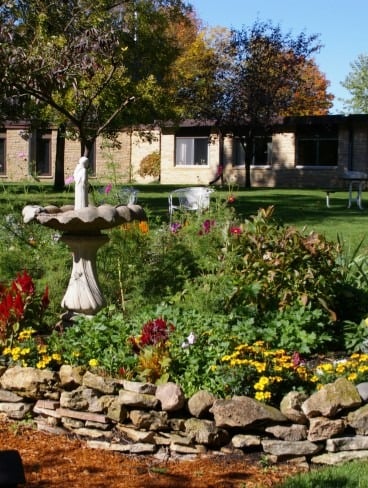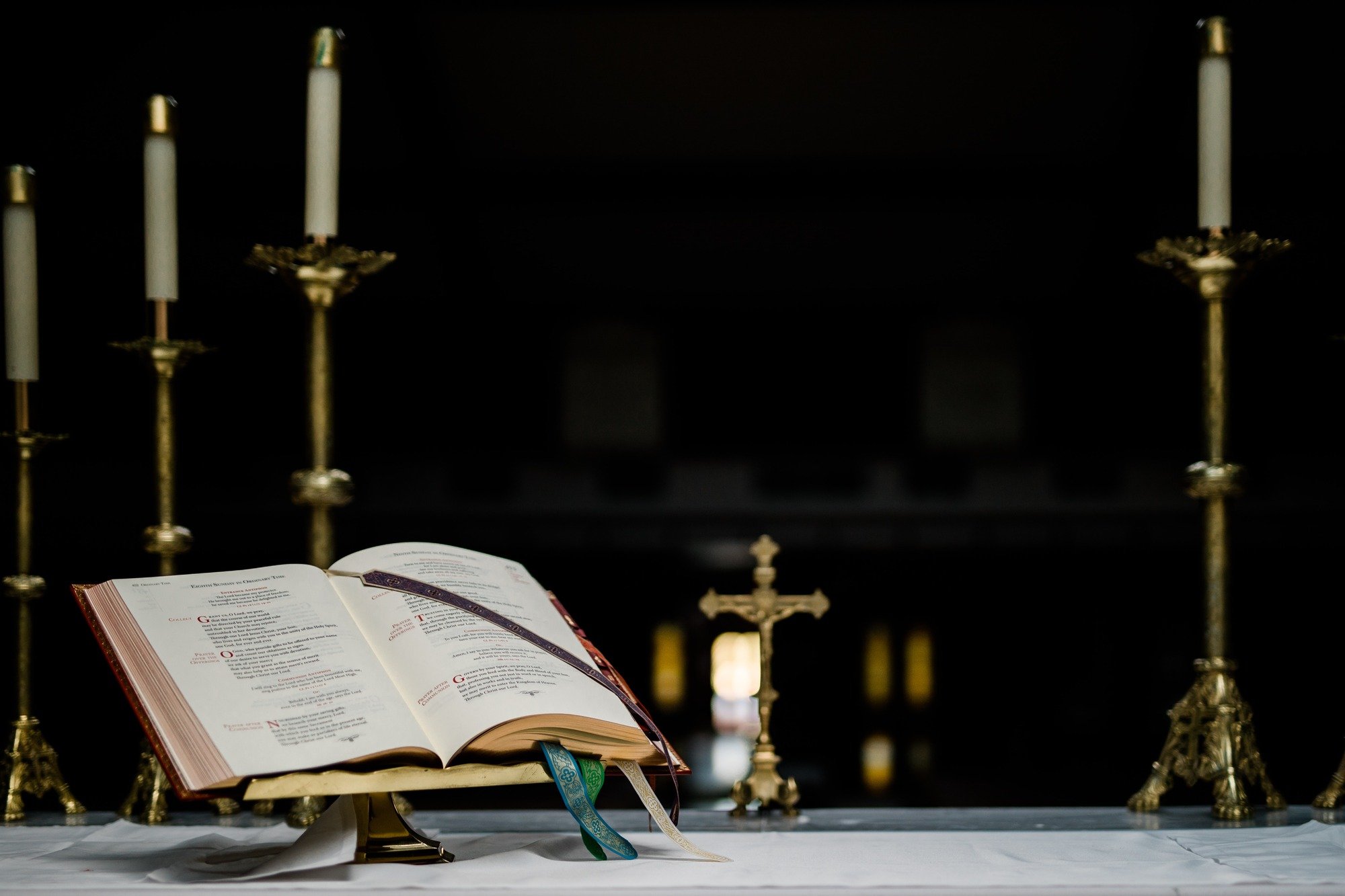Spiritual Resources - Franciscan Retreats and Spirituality Center
-
-
-
Chapel Icons
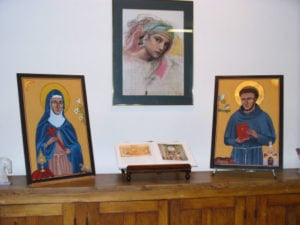
Icons of St. Francis and St. Clare grace the chapel at Franciscan Retreats
Through the generosity of the families and friends of the late retreatants Leo Justen, Katie Fox, Pat Geronime, Alvina and Daniel O’Connell, Eleanor Reasner and Isadore Gergen, two beautiful new icons, one of St. Francis and one of St. Clare, grace the main chapel of the retreat center.
The icons were commissioned by Bro. Bob Roddy, OFM Conv., Director of Franciscan Retreats and the icon Writer (“writer” is the term that is used for the artist who creates the icon) is Sister Paula Howard, OSB, a Benedictine from St. Scholastica Monastery in Atchison, Kansas.
Sister Laura Haug, OSB, prepares the boards for Sister Paula to work on. Sister Paula, transfers an outline of the images using tracing paper. With a great deal of time and care, Sister Paula will refine the images to their finished state. (An interesting note, Sister Paula had written another icon of St. Francis for person who owned a bird sanctuary. This gentleman researched the types of birds that would have been indigenous to the Umbrian region of Italy where St. Francis lived. Sister Paula relied on her work on the previous icon for the icon for Franciscan Retreats.)
About Icons
by Sister Paula Howard, OSB
Icon is the Greek word for image. Icons are basically paintings that tell stories; sacred icons tell stories from Scripture or depict an image of the Savior, Mary His Mother, or one of the saints. Considered more a form of prayer than a form of art, some icons are magnificently beautiful, but they are not created in the first place for pleasure or ornamentation. They are intended to invite the viewer to communicate with the person or event depicted in the image. Every line and every color has a meaning, just as every meter of poetry contributes to the message an author wants to tell. For this reason, icons are said to be “written” rather than painted.
For St. John Damascene in the early Christian era, the icon is the “Bible of the illiterate”: What the Bible is for an educated person, the icon is for those who cannot read or write; and what the word is for hearing, the icon is for sight. Even beyond this didactic purpose, the Eastern Church attributes a dimension of the sacred and the divine to the image, which makes a “vision of the invisible.”
Church tradition traces the first icons back to the lifetime of the Savior Himself and the period immediately after Him. In the History of the Church by St. Eusebius (265-340) we read, “I have seen a great many portraits of the Savior, and of Peter and Paul, which have been preserved to our times.” Early classical icons were written during the time of the Byzantine culture in Palestine, but the center of iconography was moved to Kiev in 988 under the rule of Vladimir. In 1240, the center of icon painting again moved to the cities of Russia where it reached its zenith in the 15 century. The past fifty years have witnessed a rebirth of appreciation of classic iconography.
The Writing of Icons
The writing of icons is considered a special vocation. The iconographer is expected to fast, pray, and live a holy life so as to be capable of expressing sacred and divine mysteries. Thus, the icon becomes, in a way, the fruit of the Holy Spirit often transmitting spiritual insight.
Although some adaptation has been made in modern times, many ancient procedures for writing icons are followed by today’s iconographers. The slab of knot-free, non-resinous wood is cut and prepared by covering it with some twelve coats of gesso, sanding after each third coat and wet-sanding after the last coat to give it a silky smooth, matte surface. Outlines of the prototype are transferred to this surface and the writing begins. Some iconographers still use egg tempera in the classic tradition, but many have turned to the use of a special brand of tempera that has a smooth texture, dries to a matte finish, and will not decompose.
One begins the writing of the icon by covering the skin areas with a shadowy deep brown color called sankir. Several coats are needed to make the area totally opaque and free of any streaks or blemishes. Lighter tones are washed on, in coat after coat, to provide the highlight areas. The same procedure is followed for each garment and background area. The halos made with delicate 18 karat gold leaf applied with a special varnish. Appropriate lettering is applied where necessary to identify the figures.
©Mount St. Scholastica, Inc., Benedictine Sisters of Atchison, Kansas.
-
-
-
Making Space for God and Yourself in a Busy World
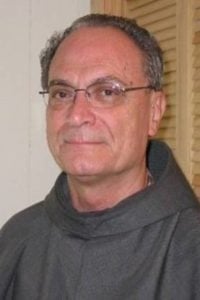 Making Space for God and Yourself in a Busy World – by Fr. Jim Van Dorn
Making Space for God and Yourself in a Busy World – by Fr. Jim Van DornSalvation means to ‘make space.’ Love makes space. Real Love gives one room to grow. We make space for each others growth today so that God’s tomorrow will not happen without us. We need to make room to experience God. We need to make space to take care of ourselves because our bodies are temples of the Holy Spirit. If you make appointments for everybody else but don’t write in appointments for your own self-care, you’re missing out. Make space for yourself so you can make high quality space for others. Coming on retreat is creating space to love and worship God. And creating space to let your creator look at his creation and love you. Through Jesus, God created space for us. God created space where we could know him through the humanity of Jesus.
-
-
-
We Remember
This page is dedicated to those Friars who are now resting in the peace of God. We remember and miss them, but take comfort knowing they’re at peace in the warm embrace of God.
Br. Ambrose Eischens, OFM Conv., 1940-2017
 After working 14 years for the US Postal Service, Friar Ambrose Eischens OFM Conv. joined the Conventual Franciscans in his mid-30s. From then on, in his service to God’s people and his fellow Friars, his work and prayer combined to the point where they became one and the same. A big man with a bass singing voice that matched his body, he overwhelmed people not with his size, but with his gentle nature and humble spirit.
After working 14 years for the US Postal Service, Friar Ambrose Eischens OFM Conv. joined the Conventual Franciscans in his mid-30s. From then on, in his service to God’s people and his fellow Friars, his work and prayer combined to the point where they became one and the same. A big man with a bass singing voice that matched his body, he overwhelmed people not with his size, but with his gentle nature and humble spirit.Br. Ambrose died Wednesday, December 20, in New Albany Indiana. He was born February 16, 1940, to Martin and Caroline (Schoenecker) Eischens in New Market, Minnesota. He was predeceased by his parents and his brothers Jerome, Harold, and LeRoy, and sisters Luella Tritz and Bernadine Benes. He is survived by his brother Wally, and a sister-in-law Ann Eischens (Jerome). He professed Simple Vows on August 1, 1977, and Solemn Vows on August 19, 1980.
Whether working with the poor and disadvantaged, running retreat centers, or serving within the Province, Br. Ambrose matched a dedication to people with attention to detail.
“In his various assignments over the course of his life, he was all about supporting and encouraging others,” said Fr. Dismas Veeneman OFM Conv. “At different points he took on difficult assignments. Some people would try to talk him out of it, but he would have none of it. That was where he felt he could make a difference in the lives of others.”
In addition to his various outside ministries and other service, Br. Ambrose was a choir member at different Franciscan parishes. He also played the organ on occasion at Mount St. Francis in southern Indiana.
“His joyfulness was most evident in his love of music and care for the Friars,” said Fr. Tom Smith OFM Conv. “And he actually chose to seek out the Friars after working for several years. That shows his great desire to live as a Franciscan.”
Having spent time earlier as a Friar in social services and outreach to the disadvantaged in Dekalb, Illinois, in his later years Br. Ambrose volunteered regularly at the Franciscan Kitchen in downtown Louisville, welcoming people at the door and listening when they needed to talk to someone.
Br. Ambrose was dedicated to his family in Minnesota, often driving to visit and support them. “He will be greatly missed,” said his niece Peggy Nagele. “We loved to see him when we could, and always looked forward to his annual Christmas letter where he would tell us about what was going on his life.”
May he rest in peace.
Fr. Jude Rochford, OFM Conv., 1926-2017

A passion for bringing out the best in those around him, matched with a profound spiritual life of prayer and devotion, made Friar Jude Rochford OFM Conv. an ideal teacher and guide for people young and old. This was especially true in his 40 years with the growing community of Conventual Franciscan Friars in Zambia, Africa, for whom he was ‘Malama’: a Bemba language name for a caring, firm, and determined mentor.
Fr. Jude passed away on November 27, 2017, in Shakopee, Minnesota. He was born James Loren Rochford on July 16, 1928, in Sumner, Iowa, to Leo and Theresa (Buzynski). He is survived by his brother Gerard and predeceased by his parents, his brother Francis, and his sisters Patricia (Sr. Nora OSF), Mary Ellen, Margaret, and Bernadette (Kindl). He professed Simple Vows July 13, 1947, and Solemn Vows on July 14, 1950. He was ordained a priest on May 30, 1955.
After ordination he taught for 11 years at Central Catholic High School in Toledo, Ohio, while completing a Master’s Degree at the University of Notre Dame. During that time he was a member of the Toledo Chapter of the Inter-Racial Council and in 1962 traveled to Selma, Alabama, to participate in a march for voter registration. Following a year teaching at Bellarmine College in Louisville, Kentucky, he was sent to Zambia as a missionary/teacher.
In addition to teaching theology and philosophy (he is especially remembered for his precise logic classes), Fr. Jude served in several administrative and leadership roles while in Zambia. But his greatest influence was in the formation of new Friars, helping them learn and grow in their Franciscan vocations.
Bishop Patrick Chisanga OFM Conv., of the Diocese of Mansa (Zambia) said that Fr. Jude was “one of those ‘angels of the Lord’ who guided me in my first steps of religious life. He left a deep influence on my understanding and appreciation of the Franciscan vocation and priesthood in general…I experienced him as a true son of St. Francis of Assisi with a profound spirit of prayer, simplicity, and particular devotion to Our Lady. He was passionate about providing adequate and integral formation to the future Friars and priests…He balanced well his firmness as a formator with a great sense of humor, which we all enjoyed.”
Recurring medical problems led to Fr. Jude’s return to the US in 2007, moving into a nursing facility near two Friaries in the Minneapolis/St. Paul area. He spent his last decade in correspondence and prayer, and welcoming family and friends. He continued to stay close to the community he left behind, Bishop Chisanga said, “writing to and praying for the Friars and priests he had nurtured along their vocation journey.”An intellectual spirit with a love of reading and writing, Fr. Jude published two books, Zambian Christian Reflections with Scriptural Readings and Journey to the Priesthood. He shared the books he read with his students, challenging them to read and write themselves.
May he rest in peace.
Fr. Juniper Cummings, OFM Conv.,
1924-2017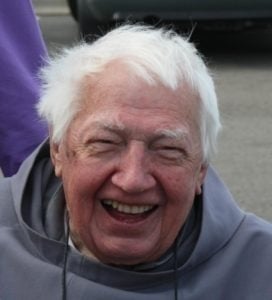 It is with the greatest sadness that I must share the following news, our dear Fr. Juniper Cummings was called by Sister Death at 7:30 a.m. on Friday, May 26 at St. Gertrude’s Health Center in Shakopee, MN. Fr. Juniper was 93 years old; he had been a Franciscan Friar for 72 years, and a Franciscan priest for 67 years.
It is with the greatest sadness that I must share the following news, our dear Fr. Juniper Cummings was called by Sister Death at 7:30 a.m. on Friday, May 26 at St. Gertrude’s Health Center in Shakopee, MN. Fr. Juniper was 93 years old; he had been a Franciscan Friar for 72 years, and a Franciscan priest for 67 years.Born in Louisville, Kentucky, Fr. Juniper attended the Minor Seminary at Mt. St. Francis, Indiana, and Our Lady of Carey, Seminary in Carey, Ohio. He completed studies for a Doctorate of Sacred Theology at the University of Fribourg in 1951.
Fr. Juniper was among some of the early faculty of Assumption Seminary in Chaska, MN. It was from the Chaska seminary that he, along with some of the other friar professors began to offer “Theology for the Laity” classes at many of the parishes in the Twin Cities area. Fr. Juniper, along with Fr. Urban Wagner, was a driving force behind the creation of Franciscan Retreats and Spirituality Center.
Fr. Juniper served as a seminary professor, a pastor, an initial formation director and director of the province’s Development Office. In 1982 he was elected Minister Provincial of the Province of Our Lady of Consolation; he served as Minister Provincial for six years. In 1989, he was elected Custos of the Custody of St. Francis, in Zambia. He remained in Zambia for 22 years before returning to the United States where he assisted with sacramental ministry at Franciscan Retreats and Spirituality Center.
While blessed with a brilliant mind for Theology and Philosophy, Fr. Juniper had the gift of conveying topics in Theology and Philosophy in an easily understood fashion. He was a visionary in the Franciscan Order and he was deeply committed to service to the poor and the marginalized. He also had a marvelous sense of humor and loved to share the many colorful stories of his life in the Franciscans.
May he rest in peace.
Bro. Bob Roddy, OFM Conv., Director, FRSC
Fr. Howard Hansen, OFM Conv.,
1930 – 2011FATHER HOWARD WILLIAM HANSEN, OFM Conv.,died Sunday April 17, 2011, at his home, St. Joseph Cupertino Friary, Prior Lake, Minnesota. Fr. Howard was born in Genoa, OH, on November 22, 1930, to Howard and Verna May (Hoppes) Hansen and baptized William.
He entered the Novitiate of the Conventual Franciscan Friars on July 4th, 1949 taking the religious name “Howard,” and professed his first vows July 4, 1950. Father Howard made his solemn profession on July 4, 1953 and was ordained to the Roman Catholic Priesthood on July 14, 1957.
As a Franciscan Friar he received an STL from the Pontifica Facolta Teologica, Rome, Italy, and a JCL from The Catholic University of America, Washington, DC. Fr. Howard served as a professor of Canon Law at Assumption Seminary Chaska, MN. While continuing work as a Canon Lawyer, he served as associate pastor or pastor of Catholic Churches in Angola, IN, Lorain, OH, Ames, IA, and Bloomington, MN. He served on the Marriage Tribunal for the Archdiocese of Saint Paul and Minneapolis in the early 1980’s. In recent years Father Howard served on the retreat team and provided sacramental ministry for Franciscan Retreats, Prior Lake, MN.
 In 1974 Fr. Howard entered Guest House for treatment of alcoholism. It was a significant turning point in his life. In his 37 years of sobriety he ministered to countless men and women affected by alcoholism. In these last months, he said that the spirituality of the 12 Steps had given him the grace to accept his physical limitations as well as to accept the loving care of his brothers in community, and the staff of Franciscan Retreats and Spirituality Center.
In 1974 Fr. Howard entered Guest House for treatment of alcoholism. It was a significant turning point in his life. In his 37 years of sobriety he ministered to countless men and women affected by alcoholism. In these last months, he said that the spirituality of the 12 Steps had given him the grace to accept his physical limitations as well as to accept the loving care of his brothers in community, and the staff of Franciscan Retreats and Spirituality Center.He was preceded in death by his parents and his beloved brother, Bobby.
Fr. Howard referred to his brother Bobby (pictured here) as “the greatest gift God gave him”.
May he rest in peace.
In loving memory
-
-
-
Spiritual Direction involves meeting one on one with a trained Spiritual Director in a relaxed setting. Spiritual Directors do not necessarily have 'all the answers' but they are skilled at helping people get off of spiritual stuck spots and pointing directees to resources that assist them on their faith journeys.
Learn more here: Spiritual Direction at Franciscan Retreats and Spirituality Center in Prior Lake MN
-
-
-
My Children Don't Go To Mass
At our parishes and retreat centers, and even in more casual conversations, we hear this question frequently. In the letters and email we receive asking for prayers, this is the number one request. And it isn’t just about high school kids – people are worried about their adult children as well. Friar Jude Winkler has some advice for parents (and grandparents) whose kids have drifted away from the Catholic faith. Frair Jude’s advice for when Children don’t go to Mass
-
-
-
Pope Francis
Pope Francis’ encyclical on the environment, “Laudato Si,” just had its fifth anniversary. It is inspired in part by St. Francis’ poem “Canticle of the Sun.”
“Laudato si, mi’ Signore” – “Praise be to you, my Lord.” In the words of this beautiful canticle, Saint Francis of Assisi reminds us that our common home is like a sister with whom we share our life and a beautiful mother who opens her arms to embrace us. “Praise be to you, my Lord, through our Sister, Mother Earth, who sustains and governs us, and who produces various fruit with coloured flowers and herbs.”
Read the encyclical Homilies of Pope Francis Pope Francis on Twitter News from the Vatican The Holy See
-
-
-
Scripture Readings
-
-
-
What's it Like to Go on a Retreat? Who goes on Retreats?

Curious to know more about our retreats? Here are some testimonies of what you can expect on a retreat, who comes, and why they do. What’s it like… Who goes…
-
-
-
Helpful Links
-
Franciscans
Franciscan Prayers
Order of Franciscan Seculars
Province of Our Lady of Consolation
Interested in becoming a Franciscan?
The Order of Friars Minor Conventual
Order of Friars Minor Conventual in the United States
National Shrine of Our Lady of Consolation, Carey, Ohio
OFM’s, Santa Barbara, California
Queen of Peace Regional Fraternity: Secular Franciscans
Portiuncula Center for Holistic Prayer: Retreat and Holistic Center, Frankfort, IL
Retreat and Spirituality Centers
King’s House, Buffalo, MN
Loyola Spirituality Center, St. Paul, MN
Benedictine Center Maplewood, MN
Jesuit Retreat House Demontreville Lake Elmo, MN
Assisi Heights Spirituality Center, Rochester, MN
Franciscan Spirituality Center, La Crosse, WI
Mount St. Francis Center for Spirituality, A Conventual Franciscan retreat center at our provincial headquarters in Indiana
Holy Cross Retreat Center, a Conventual Franciscan retreat center in New Mexico.
Tours
Franciscan Pilgrimage Programs
Archdiocese of Saint Paul and Minneapolis
Archdiocese of St Paul and Minneapolis
Cathedral of St. Paul
Basilica of St Mary, Minneapolis, MN
St. Bonaventure Catholic Community, Bloomington MN
Church of St. Michael, Prior Lake, Mn
Ss. Peter and Paul, Loretto, MN | St. Thomas the Apostle, Corcoran, MN
Church of St. Michael, Stillwater, Mn
Newspapers
The Catholic Spirit
City of Prior Lake, Minnesota
Miscellaneous
The Holy See
United States Conference of Catholic Bishops
Relevant Radio
-


